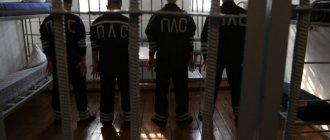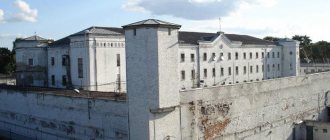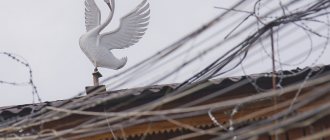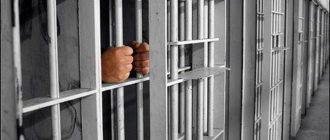Lenta.ru publishes a series of materials about special regime colonies - the most terrible zones in Russia. There, the most dangerous criminals - from maniacs and cannibals to terrorists and leaders of criminal gangs - are serving life sentences there in extremely harsh conditions. This time we will talk about the Snezhinka colony in the Khabarovsk Territory - the newest zone for life prisoners. Its security system with motion sensors, surveillance cameras and retinal scanners is considered the most advanced in Russia. The jailers in Snezhinka don’t even really need service dogs—it’s basically impossible to escape from there. And the killers and maniacs sitting there can only complain about the roar of fighters from Komsomolsk-on-Amur, which prevents them from sleeping at night...
White Swan
The maximum security correctional colony is located in the city of Solikamsk, Perm Territory, and dates back to 1938. Among all the correctional colonies in Russia, “White Swan” is distinguished by a particularly strict regime for keeping prisoners.
Criminals sentenced to life imprisonment are sent here. The chambers are designed for one, two and three people. There is a library, and since the colony is a correctional colony, a psychologist works with each prisoner.
There are many versions of the origin of the unofficial name, but the most plausible of them is based on the method of movement of prisoners. Criminals move around the colony, bending forward at 90 degrees, with their arms behind them. A peculiar “swan” pose. Despite its severity, the White Swan colony meets international standards for the detention of criminals.
2
Conditions of stay
How do they sit on the special regime? Prisoners serving sentences in a special regime penal colony may be kept in ordinary, light, strict or especially strict conditions.
Each of them has unprecedented security measures in place to reduce the likelihood of escape to a minimum.
Strict conditions
Prisoners found to have violated the regime rules of the correctional colony are placed under strict conditions for serving their sentences.
They live in cell-type premises and can:
- Spend a monthly amount of money in the amount of 70% of the minimum wage on the purchase of food and basic necessities;
- Have 2 short-term dates per year;
- Receive 1 parcel and 1 parcel per year;
- Take daily walks, lasting 1.5 hours. However, conversations with other persons are strictly prohibited;
- Work in a separate, specially equipped cell.
For good behavior observed within 12 months, the prisoner can count on transfer to normal conditions of detention.
Normal conditions
They accommodate all convicts who arrived in a special regime correctional colony. According to the legislation in force in Russia in 2022, such prisoners live in dormitories and have the right to:
- Spend monthly money in the amount of 1 minimum wage (debited from your personal account) on the purchase of food and basic necessities;
- Participate in 2 long-term (up to 3 days) and 2 short-term (up to 4 hours) dates per year;
- Receive 3 parcels (up to 2 kg) and 3 parcels or parcels (up to 20 kg) per year;
- Take daily one-and-a-half-hour walks (for good behavior, the time spent in the fresh air can be increased to 2 hours).
Having lived in normal conditions for at least a year and without receiving a single administrative penalty, the convicted person can be transferred to favorable conditions of detention.
Lighter conditions of special regime
If a prisoner serving a sentence under normal conditions does not violate the order established by the administration of the correctional institution, he may be transferred to a light regime.
Compared to the previous 2 options, it assumes more comfortable living conditions:
- Accommodation - in a dormitory;
- Monthly cash expenses – in the amount of 2 minimum wages;
- Dates – 3 short-term and 3 long-term (per year);
- Parcels, parcels and packages – 6 times a year;
- Walks are daily, one and a half hours long.
Any violation of the rules will result in immediate transfer to normal or strict containment conditions.
Particularly strict
A special regime prison with especially strict conditions of detention is intended for the most dangerous criminals.
Since most of them are prone to constant violations, suicides and escapes, increased security measures are in place here.
In such departments, not only generally accepted legislative orders reign, but also their own internal prison rules, controlled by the “supervisor”.
On a note! There are no women's colonies with a particularly strict regime in Russia.
Black Dolphin
One of the oldest colonies in Russia, founded back in 1773 near the town of Sol-Iletsk in the Orenburg region. It houses life-sentenced prisoners, and a special regime operates within the correctional facility. It is believed that this is the most terrible prison in Russia.
The first life-long prisons began to appear on the map of the Orenburg region during the reign of Catherine II. The first to try their cameras were participants in the Pugachev uprising. It received its popular name from the fountain that operates in the courtyard of the institution.
The daily routine is strictly regulated, and the radio is on almost constantly. Prisoners' walks take place in a special cell, and not in the yard. It is slightly larger than the cells in which prisoners are kept.
By the way, on our website most-beauty.ru you can find out which institutions are in the TOP 10 most luxurious prisons in the world in this interesting article.
3
What is a special regime?
The special regime in the colonies differs significantly from the general and strict regime. It can be of three types :
- lightweight;
- ordinary;
- strict.
They differ in:
- The amount of money prisoners can spend on personal needs.
- The number and duration of dates, the size of parcels.
For the first 10 years, convicts are kept under strict conditions, then they are transferred to ordinary conditions.
If the convicted person does not violate the regime, does not commit crimes, that is, behaves according to the rules, then he can qualify for a light regime.
It gives the right to spend 60% of the money from the account on personal needs, receive 4 parcels, parcels and deliveries annually, 4 short and 4 long dates throughout the year.
However, most of the convicts were disowned by all their relatives, so they receive neither parcels nor visits.
Under strict conditions, the offender is kept in solitary confinement. He is entitled to 2 short visits, which take place in a room with glass through which the convict communicates with relatives. You can also send just one transmission.
Cameras
Criminals are in cells of 2-3 people or alone . Those who pose a danger to fellow inmates and are prone to escape and attack the convoy live alone.
There are signs next to the bed and outside the cell describing the atrocities the prisoner has committed. This is done to ensure that the staff does not develop sympathy for the criminal.
Assignment to cells in the zone is based on psychological compatibility. Usually pedophiles and maniacs sit alone, since no one can withstand such proximity for more than 2-3 days.
The cells contain metal beds, chairs and tables bolted to the floor (see photo). During the day, it is forbidden to sit, much less lie on the bed ; you can only sit on chairs.
The convicts sleep, facing the door, in the light. You can’t turn your back to the wall or cover your head with a blanket. If one person violates the rules, then everyone who sits in that cell is responsible.
Also, people are required to wear only prison uniform ; wearing anything else is strictly prohibited.
The windows in the rooms are located high, so people cannot see daylight. They are under 24-hour video surveillance.
Searches are carried out every 15 minutes , for this purpose the prisoner puts his hands through the window to put on handcuffs. Then he is taken out into the corridor in a bent position. For each convict there are 3 employees with a dog.
Walking is carried out in a special small room , where air enters only from above. Movement around the colony is only possible with a blindfold, accompanied by guards with dogs. Some establishments are allowed to work.
Criminals work in separate cells of 1-2 people.
There they can paint pictures, carve wood, sew mittens, etc.
For this they are entitled to a salary , which almost entirely goes towards compensating the victims.
No cultural events are held . You are allowed to watch movies occasionally for special merits. Any communication between inmates is also excluded. Self-study is possible, but you cannot officially enter educational institutions.
The colonies have libraries with predominantly religious literature and chapels. The priest regularly visits convicts with sermons. Almost 90% of criminals begin to believe in God.
Daily regime
The morning of prisoners begins at 6.00 . Half an hour is given to make the bed and toilet. Then breakfast time begins. It is served directly into the cells through the window. After breakfast, some go to work, the rest stay in their cells. They can read books, listen to the radio.
Lunch starts at 12 . Before this, the cells are searched and prisoners are asked for complaints. After eating, you can also write letters and read. Walk for about 45 minutes in a special room.
At 7 o'clock there is dinner.
Lights out at 22:00 , after which movement in the cells is prohibited, with the exception of visiting the toilet.
Once a week, criminals are taken to the shower.
They are led to the shower room in handcuffs, then through the window the guard removes the handcuffs. Washing usually lasts 45 minutes . When necessary, a barber comes to cut the prisoners' hair.
If any health problems occur, the person is examined by a prison doctor . Every year, prisoners undergo fluorography and, if necessary, visit a dentist.
If a criminal is diagnosed with tuberculosis, HIV or hepatitis, they receive free treatment from the state. Every year, up to 900 thousand rubles are spent on 1 such patient.
Examination by a doctor is also carried out through the bars. If necessary, a course of treatment with tablets or droppers is prescribed. If there is a serious threat to the health of the patient, he is transferred to the medical unit .
When a prisoner dies, his relatives are notified. If they don't claim his body within 10 days, he is buried in a cemetery. Subsequently, relatives can carry out reburial.
Usually people live in special regime for 7-10 years, but there are those who stay there much longer. Some cannot stand it and commit suicide.
polar owl
Located in the village of Kharp in the Yamal-Nenets Autonomous Okrug on the picturesque bank of the Sob River. The colony opened for life prisoners in 1961, and its first prisoners worked on the construction of the Trans-Siberian Railway.
In those days, there were worse living conditions here, since the buildings of the institution were poorly suited for human habitation. In 2004, it received the status of a colony where especially dangerous criminals serve their life sentences.
Loud scandals are associated with the institution. The latest ones, 2012-2013, are associated with the fact that colony employees falsified confessions and exerted physical and psychological pressure to extract testimony.
4
Description of castes (suits)
There are only 4 main castes: “thieves”, “men”, “goats” and “roosters”.
- The thieves have the greatest authority and power. They establish the unwritten rules of conduct in the prison and ensure that order is maintained according to these rules. Resolving a dispute between prisoners is also the job of the thieves. The punishment of the guilty is in their hands.
- The neutral group is men. As a rule, such people do everything to get free as soon as possible and not end up in such places again. Men do not have the right to vote, they cannot participate in showdowns, nor can they serve the authorities.
- Goats. Considered a dishonorable caste. This includes those who, of their own free will, began to cooperate with the administration of the place of deprivation of liberty. The caste of goats includes those prisoners who hold any prison position - (librarian, caretaker). Goats have no rights in the criminal world, but you can greet and communicate with those who belong to this caste.
- The lowest caste is the “roosters”. Not only do they not communicate with them, even simply touching them is considered shameful. As a rule, their sleeping place is located separately, closer to the exit. They have separate dishes and cutlery. The closest distance that “roosters” can approach other prisoners is 3 steps. They are given the dirtiest job - cleaning toilets.
While every effort should be made to avoid contact with a rooster, “eating it” (when forced sexual intercourse is performed on such a convicted person) is not considered defiling.
What caste can pedophiles be in and how do they “sit”?
Child rapists are not forgiven and are not justified in any way. In prison, a pedophile is “lowered” to the “rooster” caste. But since pedophiles are considered the most unnecessary people, in the zone they do everything to prevent them from leaving alive. Moreover, it will not necessarily be murder. There are cases when a pedophile is overloaded with work to such an extent that he simply cannot stand it physically.
From the very beginning of its creation to the present day, the prison has been the main type of penitentiary institution throughout the world. Over the period of its existence, this type of institution has become a small world, with its own laws, values and concepts.
For particularly serious crimes, a person is sentenced to life imprisonment.
Such prisoners cannot be held in colonies together with other convicts.
Therefore, special regime colonies are provided for them. They differ in their detention regime and are located geographically in remote corners of Russia, from where it is almost impossible to escape.
Read about the most brutal prisons in Russia in our article.
Butyrka prison
Perhaps one of the most famous Russian prisons, founded in 1771. The largest prison in the Russian capital, and the building itself is included in the list of architectural monuments.
After the Bolsheviks came to power, it was transformed into a transit prison, and during the period of Stalinist repressions there were up to 170 people in one cell. Among the celebrities sitting here were Varlam Shalamov, designer Sergei Korolev, and Nobel Prize laureate Alexander Solzhenitsyn.
History has also recorded the famous escapes from Butyrka. In 1996, the first female escape occurred when 26-year-old Natalya Sorokozherdeva managed to escape the security perimeter.
5
Torture chambers and life of prisoners
The fate of the prisoners of the Tsar's Butyrka was extremely difficult. Even for a trivial violation of the regime, a prisoner was subject to shackles or chains. Sometimes criminals were additionally chained to the wall.
In the casemates of the prison castle there was a real factory of prolonged torture: stocks, slingshots, handcuffs, and clamps were used in abundance. The life of prisoners in the 19th century resembled that of the Middle Ages.
A couple of decades after the start of work, Butyrka found itself overcrowded with “political” prisoners. A decision was made to rebuild the main prison of Tsarist Russia. The buildings were arranged in a square shape, which made it possible to double the number of prisoners. New buildings for opponents of the regime opened in 1882. The thick walls of the cells were still saturated with dampness.
Compared to the early period of the Butyrka prison, conditions of detention have become freer. Prisoners were allowed to buy a samovar for their cell, which was a very important easing of the regime in those years. Free communication of prisoners with each other and friends in freedom was also allowed.
The detention order was tightened again after the events of 1905. A stream of fighters against tsarism poured into Butyrka, and the prison turned into hell. Flogging and beatings became a common part of the lives of unfortunate prisoners. That year, punishment cells were introduced for those who were especially persistent and who violated order.
In 1917, the prison church was closed, and the revolutionaries’ places in the cells were taken by their former opponents.
Lefortovo prison
There are special prisons in Russia, and the prison in Lefortovo is one of the most closed institutions of this type. In fact, now it is a pre-trial detention center in which dangerous criminals are awaiting sentencing.
It was formed in 1881, and lower ranks of the Russian army who committed crimes of varying severity served their sentences there. In the 20s of the twentieth century, it was converted into a prison where criminals were kept, for whom execution was replaced by imprisonment for a period of 10 years.
The contents in Lefortovo are quite harsh. Relatives are denied visits, and until 2022 there was no hot water. It is almost impossible to find out what is happening in Lefortovo, since journalists are not allowed outside the perimeter.
6
Is it possible to be released on parole?
While serving a sentence under a special regime, a prisoner becomes eligible for parole. You can be released early if you meet the conditions of Article 79 of the Criminal Code of the Russian Federation. It establishes the portion of the sentence that a prisoner must serve before being released. As a rule, this is 2/3 of the term. If the convicted person had conflicts with the administration, then he will have to spend longer behind bars.
If a citizen has been sentenced to life imprisonment, he will be able to apply for parole only 25 years after the sentencing. To date, not a single prisoner who received a life sentence has been released.
Sailor's silence
The penitentiary institution received its seemingly romantic name from the name of the street, Matrosskaya Tishina, on which it is located.
This place in Moscow has a long history. A Strait House was founded here in 1775, and literally a year later it was converted into a prison. In the first years of Soviet power, minors were kept in the building, and then the institution served as a detention facility for especially dangerous criminals. In 1956, it began to perform the functions of a pre-trial detention center.
It became famous in the 90s, when leaders of gangster groups were kept there. Sergei Mavrodi served his sentence here for financial fraud.
7
From Elban to Milan
Maxim Kiselev. Photo: Website www.mzk1.ru
Not inferior to Lozhkin in terms of the number of victims is another convict of Snezhinka, a resident of Novokuznetsk, Maxim Kiselev. In 2009, he, along with his partner Anastasia and their one-year-old daughter, arrived in the village of Orton to celebrate February 23 - Defender of the Fatherland Day, and at the same time meet the relatives of his chosen one.
On this occasion, Anastasia’s parents arranged a feast, which turned into a quarrel: the girl’s father began to scold Kiselev for beating Anastasia. In response to this, the enraged guest committed a terrible massacre in the house, not even sparing an eight-year-old boy. Kiselyov still places all the blame for his crime on counterfeit alcohol: he allegedly got drunk and suffered a memory loss, which is why he committed mass murder.
During his time in Black Golden Eagle, Kiselev became a “star” - he starred in the documentary film by Italian director Mark Franchetti “Condemned. Colony number 56." After this, the convict received letters from all over the world. One of them became fateful: Kiselev met an Italian woman named Serena, with whom he plans to tie the knot in the near future. Serena even agrees to move to Khabarovsk from Milan.
Together with Kiselev, while away his life in the village of Elban, former drug addict Dmitry Dilschneider, nicknamed Novosibirsk Raskolnikov, at whose hands five elderly residents of Novosibirsk died in 2007. He attacked pensioners for profit, killing them with a hammer and a screwdriver, after which he took away all the valuables and remaining pensions from the victims. Dilschneider tried to challenge his life sentence through the Supreme Court - however, unsuccessfully.
Crosses
The St. Petersburg “Crosses” also stand out for their strict content. They were founded in 1892, and in 2022 the prisoners were transferred to new buildings located in Kolpino. The uniqueness is that there are covered passages between the buildings with cameras.
Looking at the Old Crosses, it is difficult to imagine that this is a place where prisoners are kept. The beautiful red brick building looks more like an architectural monument. The cells remember their famous inmates, among whom were Marshal Konstantin Rokossovsky, actor Georgy Zhzhenov, and poetess Anna Akhmatova stood in lines for hours to see her son.
There have been three famous escapes throughout history. The most resonant was the escape of Lyonka Panteleev in 1922.
8
Eletskaya cover
The prison is located in the city of Yelets, Lipetsk region (Proletarskaya St., 1B, tel.: 8 (47467) 71847.
The buildings on the territory of the present Yeletskaya krytka were used as a prison back in the 16th century. Then they were simply holes dug in the ground, covered with boards on top. A stone building with prison cells appeared here in 1830.
Why is it considered one of the most terrible?
In the old days there were unbearable conditions here. Prisoners were chained to the wall for any offense and kept in cells without light or food. There was a high mortality rate in prison. Also, quite a few prisoners went crazy.
Today, Yeletskaya Krytka remains one of the most terrible prisons in Russia. All newcomers are placed in cells with “experienced” prisoners, whose goal is to intimidate the new arrivals.
There are many rumors about facts of violence against prisoners in this prison, including from the administration.
Who gets here?
About 80% of prisoners in this penal colony are serving time for murder.
Among the famous prisoners:
- Thief in law Vitalik Tbilissky.
- Tariel Oniani, also a thief in law and leader of the Kutaisi organized crime group.
- Thief in law from Chechnya Akhmed Shalinsky.
The list of such people in Yelets prison can be continued for a long time.
Vladimir Central
They knew about the famous Russian prison before, but after Mikhail Krug’s song, it became even more popular. The prison was built by decree of Empress Catherine II to hold state criminals, and in 1906 it began to be called “central”.
Now the historical building houses pre-trial detention center No. 1 in the city of Vladimir. After the overthrow of tsarism, it continued to serve as special camps and prisons for especially dangerous state criminals. Strict containment rules were established within the central area.
In 1996, on the initiative of the director of the Vladimir-Suzdal Nature Reserve, a museum began operating on the territory, which houses valuable exhibits of famous prisoners.
9
“BLACK BERKUT” (Lozva village, Sverdlovsk region (distance from Yekaterinburg - 615 km).
0
0
0
0
0
0
Correctional institution FBU IK - 56 (old name UShch 349/56) GUFSIN of Russia in the Sverdlovsk region “Black Golden Eagle” is a special regime colony for convicts sentenced to life imprisonment, as well as convicts for whom the death penalty has been replaced by pardon with life imprisonment. The occupancy limit is 499 places, including a colony-settlement site for 40 places. Location: Sverdlovsk region, Ivdel district, village. Lozva. The city of Ivdel of the Sverdlovsk region of regional subordination is part of the Northern Administrative Okrug and is located 510 km north of Yekaterinburg. Geographically located at the eastern foot of the Northern Urals, on the river. Ivdel (Ob basin), near its confluence with Lozva. Junction of railway lines to Serov, Polunochnoye, Priobye. In the 40s and early 50s, a network of forced labor camps of union subordination functioned on the territory of the Sverdlovsk region: Bogoslovlag, Sevurallag, Vosturallag, Lobvinlag, Tavdinlag, Tagillag, Urallag, Bazhenovsky ITL, ITL-100, Ivdellag, Chernoistochinsky ITL. The Ivdellag administration was located in the city of Ivdel. In the “special” Ivdel colony No. 56 “Black Golden Eagle” there were 273 “death row” prisoners in striped uniform at the end of last year. Almost all of them are murderers. Of these, 225 people were those whose death penalty was commuted to 20-25 years in prison, and 48 were those who were sentenced to life. They have more than seven hundred corpses on their conscience. Life prisoners, even among murderers, are considered outcasts. They rarely write to them from home, don’t come on dates, and don’t send packages. Their whole life is a solitary cell or in the company of others like themselves. Colony officers enter the cells of life-sentence prisoners in groups of several people, and in general they try not to enter again. On the territory of the Black Golden Eagle there is a pond with a small fountain near the administrative building. The pond is decorated with a sculpture of a black golden eagle made of concrete, holding the head of a defeated serpent in its claws. It was in his honor that FBU IK-56 began to be called “Black Golden Eagle”. Lifers live in narrow cells of six square meters, alone or together. There is no sewage system; instead of a toilet, they use a bucket, which they empty every day. Bathhouse - once a week. Prisoners spend 23 hours a day in their cell, and all they see during their hour-long walk in the small courtyard is the pale northern sky through the metal bars. Per year, lifers are entitled to one parcel and two visits of four hours each. No phone conversations, no physical contact. The conditions of detention for former suicide bombers are softer - they can talk on the phone, receive three parcels and three parcels a year, and work on a subsidiary farm. This penitentiary paradox arose during the transition from the Soviet penal system to the Russian one. Convicted: Vladimir Viktorovich Menkov - murderer, stabbed a child to death (2009 - lifelong). Mirgorod Vladimir Viktorovich - raped and killed 16 people (2012 - lifelong). Tikhomirov Ilya Yurievich - one of the organizers of the explosion at the Cherkizovsky market (2008 - lifelong). Chigrin Roman Aleksandrovich - raped and killed 2 schoolgirls (2010 - for life).
0











